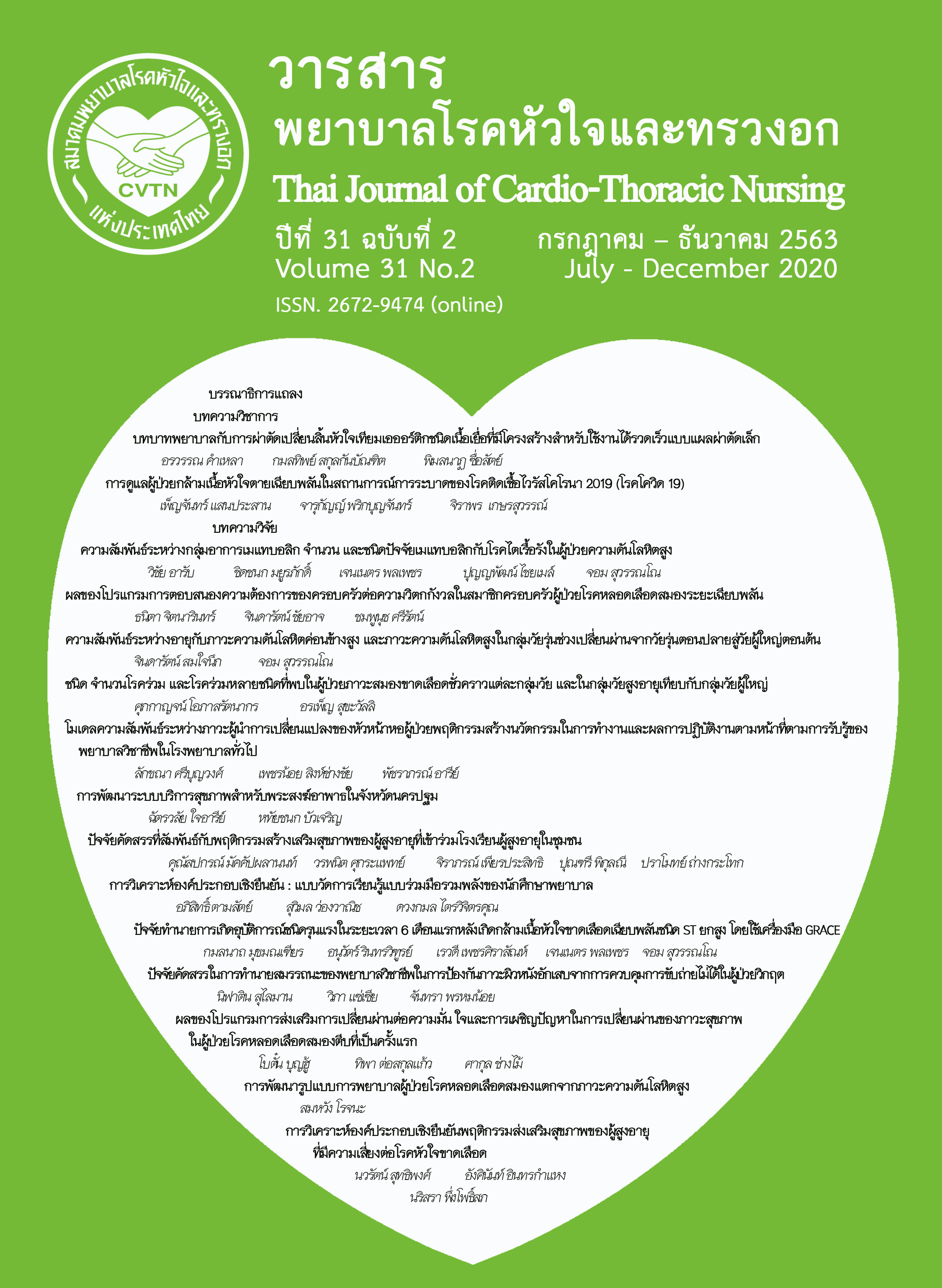The relationship model among transformational leadership of head nurses, innovative work behavior and task performance as perceived by professional nurses in general hospitals
Keywords:
task performance, transformational leadership, innovative work behavior, head nurses, professional nurses’ perceptionAbstract
The purposes of this quantitative research were analyzed structural equation model of task performance of in-patient unit professional nurses in general hospitals. The samples were 374 professional nurses, selected by multi-stage sampling. The research instruments comprised of transformational leadership, innovative work behavior and task performance questionnaires. Data were analyzed descriptive statistics and Structural Equation Modeling.
The study findings revealed that The transformational leadership, innovative work behavior and task performance had high level (mean = 3.04, SD = .53; mean = 2.69, SD = .54; mean = 3.34, SD = .40) respectively, transformational leadership and innovative work behavior had positively direct effects on task performance (β=.28, p<.01; β=.33, p<.01).The transformational leadership had a positively direct effects on innovative work behavior (β =.45, p<.01) and had indirect effects to task performance mediated by innovative work behavior (β=.15, p<.01). The structural equation model of task performance of professional nurses fitted to the empirical data (χ2/df = 2.51, GFI =0.95, CFI=0.99, RMR=0.045, RMSEA=0.064).
This study suggested that nursing administrators should provide preparation course for entering head nurse which emphasizes transformational leadership and innovative work behaviors to encourage professional nurses for higher outcome of professional nurses’ task performance.
References
Koopmans L. Measuring individual work performance. Zutphen: CPI Koninklijke Wohrmann; 2014.
Ibrahim SAEl-A, Ibrahim El Sayed R, Attala MM, Elmezin NK. Relationship between head nurses' leadership styles and staff nurses' job performance. IOSR-JNHS. 2016; 5(1): 66-74.
World Health Organization. The world health report 2008: primary health care now more than ever. World Health Report World Health Organization; 2008. [cited 2019 Oct 10]. Available from: https://www.who.int/whr/2008/whr08_en.pdf.
Rahiman H, Kodikal R. Impact of Employee Work Related Attitudes on Job Performance. BJEFM. 2017; 13 (2): 93-105.
Sawaengdee K. Crisis shortage of professional nurses in health service units the office of the permanent secretary for health: policy recommendations. Journal of Public Health. 2017; 26(2): 456 – 68. (in Thai).
Nantsupawat R, Wichaikhum O, Nantsupawat A. The relationship between nurses’ extended work hours and patient, nurse, and organizational outcomes in general hospital. Nursing Journal. 2014; 41(4): 58-69. (in Thai).
Amornprompakdee A. Report of important nursing information 2013 - 2017. 2018 [cited 2018 Sep 20]. Available from: http://www.nursing.go.th/ITNurse/Report2556-2560.pdf.
Jyoti J, Bhau S. Impact of transformational leadership on job performance: mediating role of leader–member exchange and relational identification. SAGE Open. 2015; 1(2): 1-13. [cited 2018 Sep 7]; Available from: https://journals.sagepub.com/doi/pdf/10.1177/2158244015612518
Aryee S, Walumbwa FO, Zhou Q, Hartnell CA. Transformational leadership, innovative behavior, and task performance: test of mediation and moderation processes. Hum Perform. 2012; 25: 1–25.
Harlianto J, Rudi, Afandy D. The role of leaders in stimulating innovative work behavior and its impacts towards job performance (case study: PT. XYZ). Int. J. Eng. Technol. 2018; 7(3.30): 571-74. [cited 2018 Sep 4]; Available from: https://www.sciencepubco.com/index.php/ijet/article/view/18433
Kaya N, Turanb N, Aydin GO. World conference on technology, innovation and entrepreneurship a concept analysis of innovation in nursing. Procedia Soc Behav Sci. 2015; 195: 1674 – 78. [cited 2018 Mar 5]; Available from: https://cyberleninka.org/article/n/1041644
Al-Harthy FN, Yusof NA. The impact of transformational leadership style on employee job performance: the mediating effect of training. IJSR.NET. 2013; 5(6): 499 – 503. [cited 2018 Sep 16]; Available from: https://pdfs.semanticscholar.org/0590/601cce6b91cd43a0ce9d42e4356e0fd67001.pdf
Bass BM. Bass and Stogdill’s handbook of leadership: theory, research and managerial applications. New York: Free Press; 1990.
De Jong JP, Den Hartog DN. Measuring innovative work behaviour. Creativ Innovat Manag. 2010; 19(1): 23–36.
Greenslade JH, Jimmieson NL. Distinguishing between task and contextual performance for nurses: development of a job performance scale. J Adv Nurs. 2007; 58(6): 602–11.
Krejcie RV, Morgan DW. Determining sample size for research activities. Educ Psychol Meas. 1970; 30(3): 607 – 610.
Wongcharoen W. The Structural Equation Model of Leadership of In-Patient Unit Head Nurses as Perceived by Professional Nurses, Nurses’ Work Engagement, and Job Performance of Professional Nurses in Community Hospitals. [Doctoral dissertation of nursing management]. Nakhonpathom: Christian University; 2018. (in Thai).
Jaiswal NK, Dhar RL. Transformational leadership, innovation climate, creative self-efficacy and employee creativity: A multilevel study. Int J Hospit Manag. 2015; 51: 30-41.
Best JW, Kahn JV. Research in Education,10th Edition. New York: Pearson; 2016.
Hair JF, Babin BJ, Black WC, Anderson RE. Multivariate data analysis. 8th ed. New Delhi: Cengage; 2018.
Mueller RO. Basic principles of structural equation modeling: An introduction to LISREL and EQS. New York: Springer; 1996.
Afsar B, Badir FY, Saeed BB. Transformational leadership and innovative work behavior. Ind Manag Data Syst. 2014; 114(8): 1270-1300.
Choi SB, Kim K, Ebrahim Ullah SM, Kang SW. How transformational leadership facilitates innovative behavior of Korean workers. Person Rev. 2016; 45(3): 459–79.
Contreras F, Espinosa JC, Dornberge U, Cuero Acosta YA. Leadership and employees’ innovative work behavior: test of a mediation and moderation mode. Asian Soc Sci. 2017; 13(9): 9 – 25.
Khan M, Aslam N, Riaz M. Leadership styles as predictors of innovative work behavior. PJSCP. 2012; 9(2): 17–22. [cited 2018 Sep 25]; Available from: https://www.researchgate.net/publication/234092637_Leadership_Styles_as_Predictors_of_Innovative_Work_Behavior
Schieltz KM. Impacting clinical and professional behavior through basic behavioral processes: A translation of behavioral persistence in and out of clinic. University Missouri: College of Education; 2018. [cited 2019 Jun 10]. Available from: https://thebaca.com/wp-content/uploads/2018/04/K-Schieltz-Symposium-2018.pdf.
Dörner N. Innovative work behavior: the roles of employee expectations and effects on job performance. [Doctoral dissertation of management]. Bamberg: St.Gallen University; 2012.
Chatchawan R, Trichandhara K, Rinthaisong I. Factors affecting innovative work behavior of employees in local administrative organizations in the south of Thailand. Journal of Southern Technology. 2018; 11(1): 113 – 24. (in Thai).
Majumdar B, Ray A. Transformational leadership and innovative work behaviour. J. Indian Acad. Appl. Psychol. 2011; 37(1): 140 – 48. [cited 2018 Nov 26]; Available from: https://www.researchgate.net/publication/236619084_Transformational_Leadership_and_Innovative_Work_Behaviour
Shi J. Influence of passion on innovative behavior: An empirical examination in people Republic of China. Afr J Bus Manag. 2012; 6(30): 8889 - 96.
Downloads
Published
How to Cite
Issue
Section
License
บทความนี้ยังไม่เคยตีพิมพ์หรืออยู่ในระหว่างส่งไปตีพิมพ์ในวารสารอื่น ๆ มาก่อน และกองบรรณาธิการขอสงวนสิทธิ์ในการตรวจทาน และแก้ไขต้นฉบับตามเกณฑ์ของวารสาร ในกรณีที่เรื่องของท่านได้ได้รับการตีพิมพ์ในวารสารฉบับนี้ถือว่าเป็น ลิขสิทธิ์ของวารสารพยาบาลโรคหัวใจและทรวงอก






